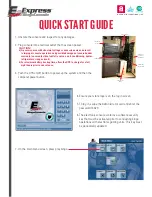
34
TK 55032-18-OP-EN
Unit Operation and Loading
Procedures
This chapter describes unit operation and proper loading procedures.
Thermo King refrigeration units are designed to maintain the required
product load temperature during transit. Transport refrigeration units are not
designed to reduce the load temperature. Follow these recommended
procedures to help prevent cargo spoilage.
Unit Operation (Before Loading Refrigerated
Cargo)
S
Stta
arrtt U
Un
niitt:: Adjust the thermostat setting to above and below the
compartment temperature to check thermostat operation.
P
Prre
e--C
Co
oo
olliin
ng
g:: With the thermostat set at the desired temperature, run the
unit for half-an-hour to one hour (or until the desired setpoint is reached)
before loading the refrigerated cargo. Pre-cooling eliminates residual heat
and acts as a good test of the refrigeration system.
D
De
effrro
osstt:: When the unit has finished pre-cooling the cargo box the
evaporator temperature should have dropped below 36°F (2.2°C). Initiate a
manual defrost cycle with the In-Cab Controller. The defrost cycle will stop
automatically.
Loading Procedure
IIm
mp
po
orrtta
an
ntt:: Product should be pre-cooled before loading. Thermo King units
are designed to maintain the load at the temperature at which it
is loaded. Transport refrigeration units are not designed to
reduce the load temperature.
N
No
otte
e:: To minimize frost accumulation in the evaporator coil and a heat
increase inside the load compartment, ensure that the unit is OFF
before opening the doors.
1. Carefully check and record the load temperature when loading the
refrigerated cargo. Note whether any products are out of temperature
range.
2. Load the product to verify sufficient air space is maintained around and
through the load in compartment. Airflow around the cargo must not be
restricted. DO NOT block the evaporator inlet or outlet. Refer to the Air
Circulation Diagram on the following page.











































